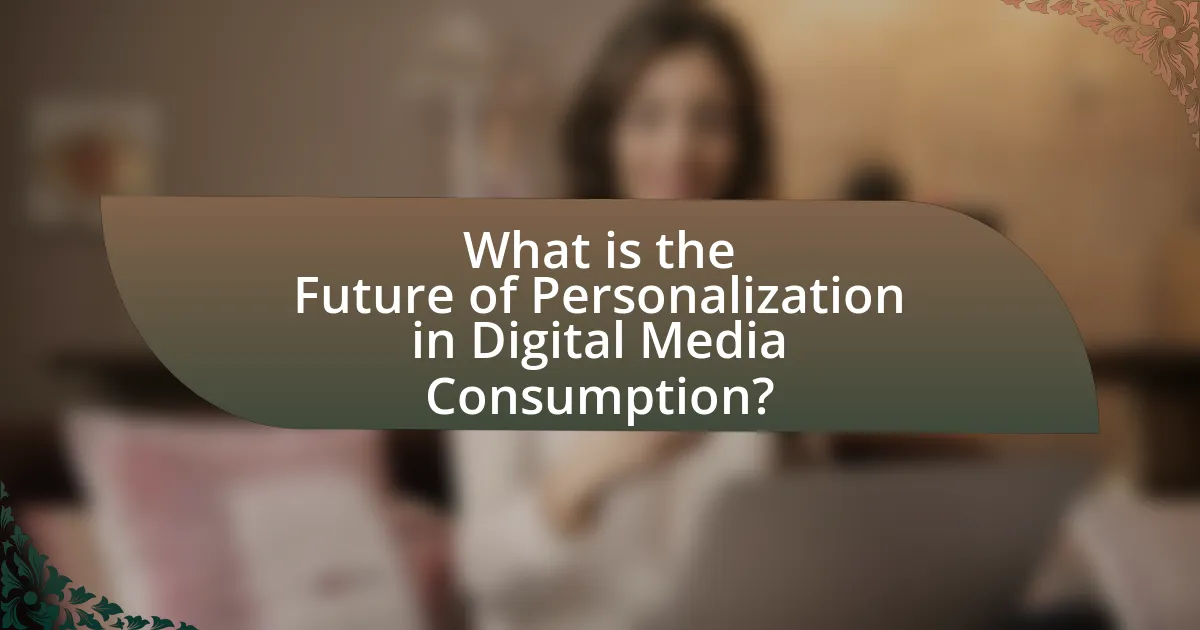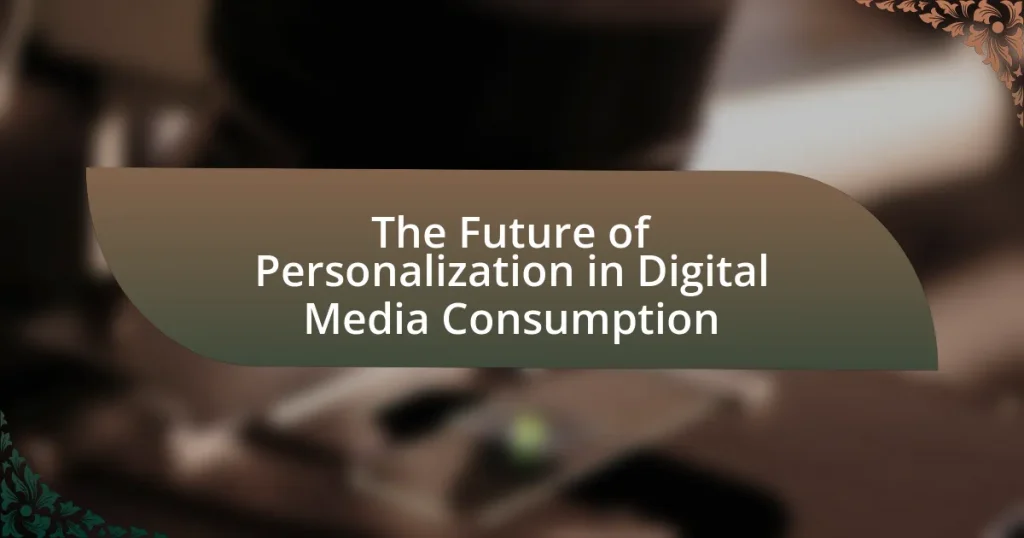The article focuses on the future of personalization in digital media consumption, emphasizing the role of advanced algorithms and artificial intelligence in delivering tailored content experiences. It outlines how user data influences personalization strategies, the technologies enabling these advancements, and the psychological effects of personalized content on consumer behavior. Key trends shaping the future include AI-driven recommendations, data analytics, and user-centric design, while challenges such as data privacy concerns and technological limitations are also discussed. The article concludes with insights on how businesses can effectively implement personalization strategies and the potential evolution of consumer expectations in this domain.

What is the Future of Personalization in Digital Media Consumption?
The future of personalization in digital media consumption will increasingly rely on advanced algorithms and artificial intelligence to deliver tailored content experiences. As user data becomes more abundant and sophisticated, platforms will utilize machine learning to analyze individual preferences, behaviors, and engagement patterns, resulting in highly customized media recommendations. For instance, a report by McKinsey & Company indicates that companies leveraging personalization can achieve a 10-30% increase in revenue, highlighting the effectiveness of targeted content strategies. This trend will likely lead to more immersive and relevant media experiences, as consumers expect content that aligns closely with their interests and viewing habits.
How is personalization defined in the context of digital media?
Personalization in the context of digital media is defined as the process of tailoring content and experiences to individual users based on their preferences, behaviors, and demographics. This approach enhances user engagement by delivering relevant information, recommendations, and advertisements that align with the user’s interests. For instance, platforms like Netflix and Spotify utilize algorithms that analyze user activity to suggest movies or music, thereby increasing user satisfaction and retention. Research indicates that personalized experiences can lead to a 20% increase in user engagement, demonstrating the effectiveness of this strategy in digital media consumption.
What technologies enable personalization in digital media?
Technologies that enable personalization in digital media include artificial intelligence (AI), machine learning algorithms, data analytics, and recommendation systems. AI and machine learning analyze user behavior and preferences to tailor content, while data analytics processes large datasets to identify trends and insights. Recommendation systems, such as those used by platforms like Netflix and Amazon, utilize these technologies to suggest relevant content based on individual user interactions and historical data. For instance, Netflix’s algorithm leverages viewing history and user ratings to provide personalized show recommendations, demonstrating the effectiveness of these technologies in enhancing user experience.
How does user data influence personalization strategies?
User data significantly influences personalization strategies by enabling companies to tailor content and experiences to individual preferences and behaviors. By analyzing user interactions, such as browsing history, purchase patterns, and demographic information, businesses can create targeted recommendations and advertisements that resonate with specific audiences. For instance, a study by McKinsey & Company found that personalized experiences can lead to a 10-30% increase in revenue, demonstrating the effectiveness of leveraging user data for strategic personalization. This data-driven approach not only enhances user engagement but also fosters customer loyalty by providing relevant and timely content.
Why is personalization important for digital media consumers?
Personalization is important for digital media consumers because it enhances user engagement and satisfaction by delivering tailored content that aligns with individual preferences. Research indicates that 80% of consumers are more likely to make a purchase when brands offer personalized experiences, demonstrating the effectiveness of personalization in driving consumer behavior. Furthermore, personalized recommendations can increase content consumption time by up to 30%, as users are more likely to engage with content that resonates with their interests. This data underscores the critical role of personalization in improving the overall digital media experience for consumers.
What are the psychological effects of personalized content?
Personalized content significantly influences psychological effects, primarily by enhancing user engagement and satisfaction. This tailored approach fosters a sense of relevance and connection, leading to increased emotional investment in the content. Research indicates that personalized experiences can trigger positive emotional responses, such as happiness and contentment, as users feel understood and valued. For instance, a study published in the Journal of Consumer Research by Arora et al. (2008) found that personalized marketing messages led to higher levels of consumer trust and loyalty, demonstrating the psychological impact of feeling recognized. Additionally, personalized content can also lead to negative effects, such as anxiety or frustration when users feel overwhelmed by excessive targeting or when the content does not align with their expectations. Overall, the psychological effects of personalized content are multifaceted, influencing both positive engagement and potential negative emotional responses.
How does personalization enhance user engagement and satisfaction?
Personalization enhances user engagement and satisfaction by tailoring content and experiences to individual preferences and behaviors. When users receive recommendations or content that align with their interests, they are more likely to interact with the platform, leading to increased time spent and higher satisfaction levels. Research indicates that personalized experiences can boost engagement rates by up to 50%, as users feel more connected to content that resonates with them. This connection fosters loyalty and encourages repeat visits, ultimately enhancing overall user satisfaction.
What trends are shaping the future of personalization in digital media?
The future of personalization in digital media is being shaped by advancements in artificial intelligence, data analytics, and user-centric design. Artificial intelligence enables more sophisticated algorithms that analyze user behavior and preferences, allowing for tailored content recommendations. Data analytics provides insights into audience segmentation, enhancing the ability to deliver personalized experiences based on real-time data. User-centric design focuses on creating intuitive interfaces that adapt to individual user needs, improving engagement and satisfaction. These trends are supported by industry reports, such as the 2022 Deloitte Digital Media Trends, which highlight that 80% of consumers are more likely to engage with brands that offer personalized experiences.
How are AI and machine learning transforming personalization?
AI and machine learning are transforming personalization by enabling highly tailored experiences based on individual user data and behavior. These technologies analyze vast amounts of data to identify patterns and preferences, allowing businesses to deliver content, recommendations, and advertisements that resonate with each user. For instance, Netflix utilizes machine learning algorithms to analyze viewing habits and suggest shows that align with user interests, resulting in a 75% increase in viewer engagement. This data-driven approach not only enhances user satisfaction but also drives higher conversion rates for businesses, demonstrating the significant impact of AI and machine learning on personalization in digital media consumption.
What role do social media platforms play in personalized content delivery?
Social media platforms play a crucial role in personalized content delivery by utilizing algorithms that analyze user behavior, preferences, and interactions to curate tailored content. These platforms collect vast amounts of data, including likes, shares, and comments, which inform their recommendation systems. For instance, Facebook’s algorithm prioritizes posts that align with a user’s interests, resulting in a feed that reflects individual preferences. Research indicates that personalized content can increase user engagement by up to 50%, demonstrating the effectiveness of these algorithms in enhancing user experience and satisfaction.
How can businesses effectively implement personalization strategies?
Businesses can effectively implement personalization strategies by leveraging data analytics to understand customer preferences and behaviors. By collecting and analyzing data from various touchpoints, such as website interactions, purchase history, and social media engagement, businesses can create tailored experiences that resonate with individual customers. For instance, a study by McKinsey & Company found that personalized marketing can lead to a 10-30% increase in revenue, demonstrating the financial benefits of such strategies. Additionally, utilizing machine learning algorithms can enhance the accuracy of personalization efforts, allowing businesses to predict customer needs and deliver relevant content or product recommendations in real-time.
What are the best practices for collecting user data ethically?
The best practices for collecting user data ethically include obtaining informed consent, ensuring transparency, and implementing data minimization. Informed consent requires that users are fully aware of what data is being collected, how it will be used, and who it will be shared with, allowing them to make an educated decision about their participation. Transparency involves clearly communicating privacy policies and practices, which fosters trust between users and organizations. Data minimization means only collecting data that is necessary for the intended purpose, reducing the risk of misuse or breaches. According to the General Data Protection Regulation (GDPR), these practices are not only ethical but also legally required in many jurisdictions, reinforcing their importance in responsible data collection.
How can businesses measure the success of their personalization efforts?
Businesses can measure the success of their personalization efforts through key performance indicators (KPIs) such as conversion rates, customer engagement metrics, and customer satisfaction scores. For instance, a study by McKinsey & Company found that companies that excel in personalization can increase their sales by 10% to 30% due to improved customer experiences. Additionally, tracking metrics like click-through rates and average order value can provide concrete evidence of the effectiveness of personalized marketing strategies. By analyzing these data points, businesses can assess the impact of their personalization initiatives on overall performance and customer loyalty.
What challenges do companies face in personalizing digital media?
Companies face several challenges in personalizing digital media, primarily including data privacy concerns, technological limitations, and the complexity of consumer behavior. Data privacy regulations, such as the General Data Protection Regulation (GDPR), restrict how companies can collect and use personal information, making it difficult to tailor content effectively. Technological limitations arise from the need for advanced algorithms and infrastructure to analyze vast amounts of data in real-time, which many companies may lack. Additionally, understanding the complexity of consumer behavior is challenging, as preferences can change rapidly and vary widely among different demographics. These factors collectively hinder the ability of companies to deliver personalized experiences that resonate with their audiences.
How do privacy concerns impact personalization strategies?
Privacy concerns significantly hinder personalization strategies by limiting the data available for tailoring user experiences. When consumers are apprehensive about how their personal information is collected and used, they often opt out of data-sharing practices or use privacy settings that restrict data access. For instance, a survey by Pew Research Center in 2021 indicated that 81% of Americans feel that the potential risks of companies collecting their data outweigh the benefits. This widespread concern leads companies to either reduce the granularity of their personalization efforts or invest in more transparent data practices, which can dilute the effectiveness of personalized marketing. Consequently, businesses must navigate the balance between leveraging data for personalization and respecting user privacy, often resulting in less targeted and less effective strategies.
What technological barriers exist in implementing effective personalization?
Technological barriers in implementing effective personalization include data privacy concerns, integration challenges, and algorithmic limitations. Data privacy regulations, such as GDPR, restrict how companies can collect and use personal data, hindering the ability to create tailored experiences. Integration challenges arise when disparate systems and platforms do not communicate effectively, leading to fragmented user profiles and inconsistent personalization. Additionally, algorithmic limitations, including biases in machine learning models and insufficient data quality, can result in ineffective personalization strategies. These barriers collectively impede the ability to deliver truly personalized digital media experiences.
What is the potential future landscape of personalized digital media consumption?
The potential future landscape of personalized digital media consumption will be characterized by advanced algorithms and AI-driven technologies that tailor content to individual preferences in real-time. As data analytics and machine learning continue to evolve, platforms will increasingly leverage user behavior, preferences, and contextual information to deliver highly relevant media experiences. For instance, a report by McKinsey indicates that companies utilizing personalization can achieve a 10-30% increase in revenue, demonstrating the effectiveness of targeted content delivery. Furthermore, the integration of augmented reality (AR) and virtual reality (VR) will enhance user engagement by providing immersive experiences that adapt to personal tastes. This shift towards hyper-personalization will redefine how consumers interact with digital media, making it more intuitive and aligned with their unique interests.
How might consumer expectations evolve regarding personalization?
Consumer expectations regarding personalization are likely to evolve towards a demand for greater relevance and immediacy in digital interactions. As technology advances, consumers increasingly expect brands to deliver tailored experiences that reflect their individual preferences and behaviors in real-time. For instance, a study by Epsilon found that 80% of consumers are more likely to make a purchase when brands offer personalized experiences, indicating a strong correlation between personalization and consumer satisfaction. This trend suggests that as data analytics and artificial intelligence improve, consumers will anticipate even more sophisticated personalization, such as predictive recommendations based on their past interactions and contextual factors.
What innovations could redefine personalization in the coming years?
Innovations such as artificial intelligence-driven algorithms, augmented reality experiences, and advanced data analytics are poised to redefine personalization in the coming years. AI algorithms can analyze user behavior in real-time, enabling highly tailored content recommendations that adapt to individual preferences. For instance, Netflix employs machine learning to suggest shows based on viewing history, resulting in a 75% increase in user engagement. Augmented reality can create immersive experiences that personalize interactions with digital content, allowing users to visualize products in their own environment before purchase. Furthermore, advanced data analytics can aggregate and interpret vast amounts of user data, leading to more precise targeting and personalization strategies. These innovations collectively enhance user experience and engagement in digital media consumption.
What practical tips can enhance personalization in digital media consumption?
To enhance personalization in digital media consumption, users should actively curate their content preferences through settings and feedback mechanisms. By adjusting algorithms based on viewing history, likes, and dislikes, platforms can tailor recommendations more effectively. Research indicates that personalized recommendations can increase user engagement by up to 70%, as seen in platforms like Netflix and Spotify, which utilize user data to refine their suggestions. Additionally, engaging with interactive features, such as rating content or participating in surveys, further informs algorithms, leading to a more customized experience.




